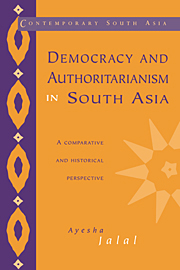Book contents
- Frontmatter
- Contents
- List of maps
- Preface
- Introduction
- 1 The colonial legacy in India and Pakistan
- 2 State formation and political processes in India and Pakistan, 1947 to c.1971
- 3 The ‘populist’ era and its aftermath in India, Pakistan and Bangladesh, 1971 to c.1993
- 4 The state and political economy, 1947 to c.1993
- 5 Central power and regional dissidence
- 6 Societies, cultures and ideologies: hybrids in contrived monoliths
- 7 Conclusion
- Bibliographical essay
- Index
Introduction
Published online by Cambridge University Press: 26 October 2009
- Frontmatter
- Contents
- List of maps
- Preface
- Introduction
- 1 The colonial legacy in India and Pakistan
- 2 State formation and political processes in India and Pakistan, 1947 to c.1971
- 3 The ‘populist’ era and its aftermath in India, Pakistan and Bangladesh, 1971 to c.1993
- 4 The state and political economy, 1947 to c.1993
- 5 Central power and regional dissidence
- 6 Societies, cultures and ideologies: hybrids in contrived monoliths
- 7 Conclusion
- Bibliographical essay
- Index
Summary
Among the more fascinating themes in contemporary South Asia has been the ‘success’ of democracy in India and its ‘failure’ in neighbouring Pakistan and Bangladesh. Yet studies of democratic politics in India and military dominated authoritarian states in Pakistan and Bangladesh have rarely addressed, far less explained, why a common British colonial legacy led to apparently contrasting patterns of political development in post-independence South Asia. The lacuna in the literature is surprising given the oft-heard scholarly laments about the artificial demarcation of the subcontinent's political frontiers at the time of the British withdrawal. Many historians are coming to question the inclusionary and exclusionary claims of both Indian and Muslim nationalisms and, more guardedly, the appropriateness of the concept of the ‘nation-state’ in subcontinental conditions. The spatial and temporal artifact that has been the modern nationstate in post-1947 South Asia nevertheless remains inextricably stitched on to the scholarly canvas.
Analyses premised on historical disjunctions, even when acknowledged as arbitrary, tend to emphasize differences rather more than similarities. The loss of a subcontinental vision has not only compartmentalized South Asian historiography but deflected from any sort of comparative understanding of the common dilemmas of the region's present and the interlocking trajectories of its future. While most historians see the dividing line of 1947 as the outer periphery of their scholarly terrain, politicial scientists take it as an obvious point of entry from where to begin analysing the state–society nexus in India, Pakistan or Bangladesh.
- Type
- Chapter
- Information
- Democracy and Authoritarianism in South AsiaA Comparative and Historical Perspective, pp. 1 - 8Publisher: Cambridge University PressPrint publication year: 1995

